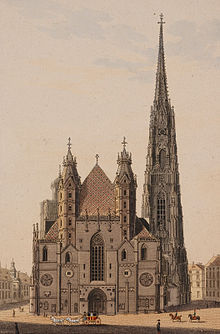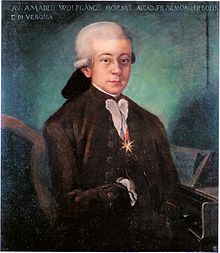- Mozart and Roman Catholicism
-
 St. Stephen's Cathedral, Vienna, the most important edifice of the Roman Catholic Church in Vienna. Mozart's marriage and funeral took place here.
St. Stephen's Cathedral, Vienna, the most important edifice of the Roman Catholic Church in Vienna. Mozart's marriage and funeral took place here.
The celebrated composer Wolfgang Amadeus Mozart (1756–1791) was raised Roman Catholic and remained a loyal member of the Catholic Church throughout his life.[1]
Contents
Life
Catholic upbringing
Mozart's parents (Leopold Mozart and Anna Maria Mozart) were Catholics and raised their children in this religion, insisting upon strict obedience to the requirements of the Church.[2] They encouraged family prayer, fasting, the veneration of saints, regular attendance at Mass, and frequent confession.[3]
Leopold Mozart continued to urge strict observance upon Wolfgang even when the latter had entered adulthood. In 1777, he wrote to his wife and son, who at the time were on their journey to Paris:
- Is it necessary for me to ask whether Wolfgang is not perhaps getting a little lax about confession? God must come first! From His hands we receive our temporal happiness; and at the same time we must think of our eternal salvation. Young people do not like to hear about these things, I know, for I was once young myself. But, thank God, in spite of all my youthful foolish pranks, I always pulled myself together. I avoid all dangers to my soul and ever kept God and my honor and the consequences, the very dangerous consequences, before my eyes.[4]
By "very dangerous consequences", Leopold was most probably referring to a specific doctrine of Catholicism, namely that persons who die in a state of mortal sin will experience eternal punishment in hell. Leopold extended another important element of Catholic belief—the existence of earthly miracles as signs from God—to the case of his son, whose abilities he considered to have a divine origin. In 1768, he wrote to his friend Lorenz Hagenauer, describing his son as
- a miracle, which God has allowed to see the light in Salzburg ... And if it is ever to be my duty to convince the world of this miracle, it is so now, when people are ridiculing whatever is called a miracle and denying all miracles ... But because this miracle is too evident and consequently not to be denied, they want to suppress it. They refuse to let God have the honor.[5]
In the phrase "denying all miracles," Leopold may have been referring to the emerging values of the Enlightenment, at the time in full swing. Participants in this cultural movement often favored scientific (as opposed to miraculous) explanations of natural phenomena.
Order of the Golden Spur
As a teenager, Mozart went on tours of Italy, accompanied by his father. During the first of these, Leopold and Wolfgang visited Rome (1770), where Wolfgang was awarded the Order of the Golden Spur, a form of honorary knighthood, by Pope Clement XIV. The papal patent for the award said:
- Inasmuch as it behoves the beneficence of the Roman Pontiff and the Apostolic See that those who have shown them no small signs of faith and devotion and are graced with the merits of probity and virtue, shall be decorated with the honours and favors of the Roman Pontiff and the said See. (4 July 1770)[6]
The following day Mozart received his official insignia, consisting of "a golden cross on a red sash, sword, and spurs," emblematic of honorary knighthood.[7] The papal patent also absolved the awardee from any previous sentence of excommunication (unnecessary in Mozart's case) and stated "it is our wish that thou shalt at all times wear the Golden Cross." In the 1777 painting (shown here) known as the "Bologna Mozart", Mozart is indeed shown wearing his knightly insignia. Mozart's Golden Spur decoration was the source of an unpleasant incident in October 1777, when he visited Augsburg during the job-hunting tour (1777–1779) that ultimately took him to Paris. Following the advice of his father,[8] Mozart wore his insignia in public, and in particular to a dinner arranged by a young aristocrat named Jakob Alois Karl Langenmantel. Langenmantel and his brother-in-law teased Mozart mercilessly about the insignia, and Mozart ultimately was moved to reply very sharply and eventually depart.[9] Thenceforth Mozart showed condiderably more caution in wearing his decoration.[10]
Freemasonry
Main article: Mozart and FreemasonryMozart joined the Freemasons in 1784, and remained an active member until his death; see Mozart and Freemasonry. His choice to enter the "Zur Wohltätigkeit" lodge was influenced by his friendship with the lodge's master, Baron Otto Heinrich von Gemmingen-Hornberg, and his attraction to the lodge's "shared devotion to Catholic tradition."[11] Freemasonry was banned by the Catholic Church in a Papal Bull issued by Pope Clement XII on 28 April 1738. The ban, however, "was published and came into force only in the Papal States, Spain, Portugal, and Poland."[12] It was not promulgated in Austria, where Mozart lived, until 1792 (after Mozart's death). Hence, although the Catholic Church's opposition to Freemasonry would eventually become known in Austria, during Mozart's lifetime "a good Catholic could perfectly well become a Mason," and it is clear that Mozart saw no conflict between these two allegiances.[13]
Last rites
There has been considerable scholarly debate over the question of whether Mozart received last rites of the Catholic Church on his death bed. In 1825, Mozart's sister-in-law Sophie Haibel, by then elderly, prepared a brief memoir of Mozart's death for her brother-in-law Georg Nikolaus von Nissen, the second husband of Mozart's widow Constanze, who was writing a Mozart biography.[14] Nissen, who like Sophie was living in Salzburg at the time, conferred with Sophie and wrote marginal notes in her memorandum. While Sophie remembered that she had sent for a priest to come give Mozart the last rites, a marginal note in Nissen's hand indicates "The priests declined to come because the sick person himself did not send for them."[15] The note added by Nissen, however, conflicts with a later annotation of Sophie's letter, which states that a priest did come, and that although a period of unconsciousness made it impossible for Mozart to receive the viaticum, he was given extreme unction.[16][17]
While it is unclear whether Mozart received last rites on his deathbed, there is no evidence suggesting that he refused them. Even Nissen, who was of the opinion that the priests failed to come, notes, "If he hadn't been neglected [by the priests], he would have received the last rites."[18]
According to Gutman, the reason for the priests' delay, or failure, in attending to Mozart was due to confusion. Constanze, who had sent Sophie to find a priest to administer last rites for her husband, wanted "a priest to arrive alone, as if on a passing, spontaneous sick call," in order to spare Mozart "the alarm at the sight and sounds of the last rites in full form—sextons ringing bells as they escorted a cleric in vestments."[19] It is likely that the priests' tardiness was due to Sophie's failure to explain Constanze's strategy, or, in any case, her inability to communicate to him the urgency of the situation.[19]
Funeral
Mozart received a Catholic funeral service at St. Stephen's Cathedral and was given postmortem last rites at a Requiem mass in St. Michael's church.[20]
Mozart's religious beliefs
The degree of Mozart's personal commitment to Catholic doctrine is difficult to determine. Ruth Halliwell, a contributor to The Cambridge Mozart Encyclopedia, writes, "An educated guess at the totality of Mozart's beliefs based on reconciling the motley evidence would probably posit a broad belief in Christianity, but impatience with many of the requirements of the Catholic church."[20] Another contributor, Bruce MacIntyre, suggests that Mozart "seems to have been a freethinking Catholic with a private relationship to God."[21]
Liturgical works
During his lifetime, Mozart composed more than 60 pieces of sacred music; for a partial listing, see List of compositions by Wolfgang Amadeus Mozart. The majority were written between 1773 and 1781, when he was employed as court musician to the Prince-Archbishop of Salzburg.[1] Important later liturgical works included the Mass in C minor (K. 427), written for the Salzburg visit of 1783, the motet Ave verum corpus (K. 618), written in Baden in 1791, and the Requiem mass (K. 626), left incomplete at Mozart's death.
Notes
- ^ a b Allen, John (1 September 2006). "Mozart: Catholic, Master Mason, favorite of the pope". National Catholic Reporter. Archived from the original on 4 December 2007. http://web.archive.org/web/20071204040828/http://ncronline.org/NCR_Online/archives2/2006c/090106/090106i.php. Retrieved 10 November 2007.
- ^ Alfred Einstein, Mozart, His Character, His Work, Oxford University Press: 1945, p. 77.
- ^ Eisen and Keefe (2006, 324)
- ^ Quote in Solomon 1995, 31
- ^ Solomon 1995, 5
- ^ Printed in translation in Deutsch 1965, 123–124
- ^ Deutsch 1965, 124
- ^ Schroeder (1999:87)
- ^ The incident is described in detail in Melograni (2006:75–76), relying on a letter from Mozart to his father dated 16 October.
- ^ Schroeder (1999:87)
- ^ Gutman 1999, 645
- ^ Fahlbusch 2003, 449
- ^ Einstein 1945, 81/84
- ^ The memoir is printed, without Nissen's annotations, in Deutsch (1965)
- ^ Solomon 1995, 497
- ^ Eisen and Keefe 2006, 207
- ^ Gutman 1999, 743-44
- ^ Solomon 1995, 589
- ^ a b Gutman 1999, 743
- ^ a b Eisen and Keefe 2006, 325
- ^ Eisen and Keefe 2006, 415
References
- Abert, Hermann (2007) W.A. Mozart, Yale University Press.
- Anderson, Emily (1938) The Letters of Mozart and His Family, Macmillan and Co.
- Braunbehrens, Volkmar (1990) Mozart in Vienna.
- Deutsch, Otto Erich (1965) Mozart: A Documentary Biography. Stanford: Stanford University Press.
- Eisen, Cliff and Simon P. Keefe (2006) The Cambridge Mozart encyclopedia, Cambridge University Press.
- Fahlbusch, Erwin (2003) The Encyclopedia of Christianity, Eerdmans Publishing Company.
- Gutman, Robert W. (1999) Mozart: A Cultural Biography, Harcourt Brace & Company.
- Melograni, Piero (2006) Wolfgang Amadeus Mozart. Chicago: University of Chicago Press.
- Schroeder, David P. (1999) Mozart in Revolt. New Haven: Yale University Press.
- Solomon, Maynard (1995) Mozart: A Life. New York: Harper Collins.
Wolfgang Amadeus Mozart Family 
Biography Works Influences - Haydn and Mozart
- Salieri and Mozart
- Mozart and Beethoven
- Mozart and Prague
- Mozart and Roman Catholicism
- Mozart and Freemasonry
Categories:- Wolfgang Amadeus Mozart
- Religious views by individual
Wikimedia Foundation. 2010.

